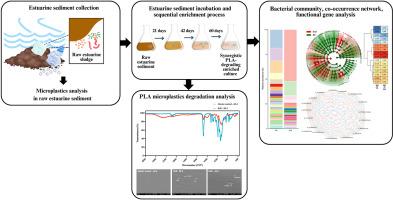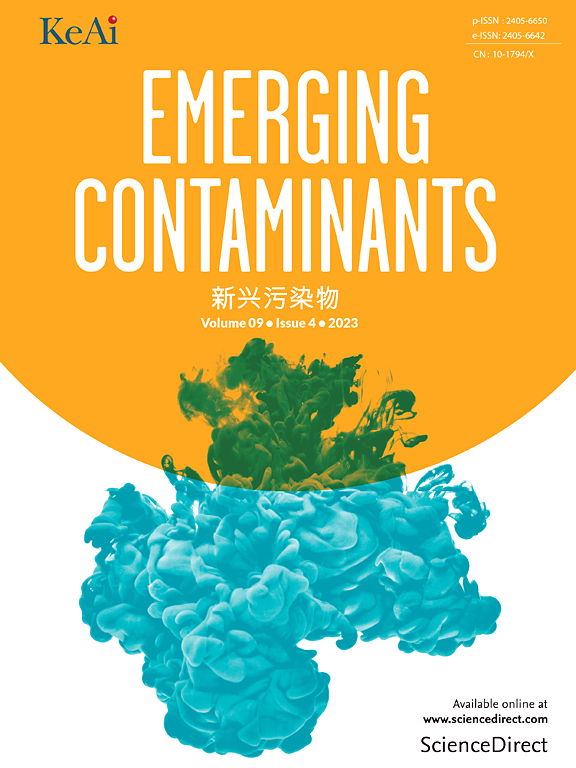Diversity and functional genes of bacterial communities enriched from an estuarine sediment for degradation of polylactic acid microplastics
IF 6.9
2区 环境科学与生态学
Q1 ENVIRONMENTAL SCIENCES
引用次数: 0
Abstract
The accumulation of polylactic acid (PLA) microplastics (MPs) in estuaries presents significant environmental challenges. The potential biodegradation of PLA MPs was rarely studied in estuarine sediments from urban areas. This study examined PLA MPs biodegradation during enrichment and assessed microbial diversity and functional gene shifts between raw estuarine sediment (day 0) and enriched culture (day 60). The enriched culture at 60-day post-incubation reduced the 40 % weight of the initial 2 g L−1 PLA MPs, accompanied by a decrease in the carbonyl peak at 1747 cm−1, indicating oxidative polymer chain cleavage. In addition, the biodegradation process significantly altered microbial diversity and promoted key synergistic genera such as Symbiobacterium, Sphingobacterium, Comamonas, Pseudomonas, and Alcaligenes for cooperative PLA MPs biodegradation. Linear discriminant analysis scores highlighted the distinct differences in microbial profiles between the raw estuarine sediment and the enriched culture. In addition, functional genes including pht2, tphA2, putative chitinase, esterase, and lipase were enriched, which would facilitate biopolymer and phthalate degradation. These findings revealed how PLA MP exposure affected microbial carbon and nitrogen metabolism in estuarine sediment and uncovered synergistic bacterial taxa with biotechnological potential for sustainable plastic waste treatment.

河口沉积物富集降解聚乳酸微塑料细菌群落的多样性和功能基因
聚乳酸(PLA)微塑料(MPs)在河口的积累提出了重大的环境挑战。PLA MPs在城市河口沉积物中的潜在生物降解研究很少。本研究检测了PLA MPs在富集过程中的生物降解,并评估了原始河口沉积物(第0天)和富集培养物(第60天)之间的微生物多样性和功能基因转移。孵育后60天的富集培养减少了最初2 g L−1 PLA MPs的40%重量,同时羰基峰在1747 cm−1处下降,表明氧化聚合物链断裂。此外,生物降解过程显著改变了微生物多样性,并促进了关键的协同属,如共生菌、鞘菌、单胞菌、假单胞菌和Alcaligenes,以协同降解PLA MPs。线性判别分析分数突出了原始河口沉积物和富集培养物之间微生物谱的明显差异。此外,pht2、tphA2、几丁质酶、酯酶和脂肪酶等功能基因被富集,有助于生物聚合物和邻苯二甲酸盐的降解。这些发现揭示了PLA MP暴露如何影响河口沉积物中微生物的碳和氮代谢,并揭示了具有可持续塑料废物处理生物技术潜力的协同细菌分类群。
本文章由计算机程序翻译,如有差异,请以英文原文为准。
求助全文
约1分钟内获得全文
求助全文
来源期刊

Emerging Contaminants
Medicine-Public Health, Environmental and Occupational Health
CiteScore
10.00
自引率
6.70%
发文量
35
审稿时长
44 days
期刊介绍:
Emerging Contaminants is an outlet for world-leading research addressing problems associated with environmental contamination caused by emerging contaminants and their solutions. Emerging contaminants are defined as chemicals that are not currently (or have been only recently) regulated and about which there exist concerns regarding their impact on human or ecological health. Examples of emerging contaminants include disinfection by-products, pharmaceutical and personal care products, persistent organic chemicals, and mercury etc. as well as their degradation products. We encourage papers addressing science that facilitates greater understanding of the nature, extent, and impacts of the presence of emerging contaminants in the environment; technology that exploits original principles to reduce and control their environmental presence; as well as the development, implementation and efficacy of national and international policies to protect human health and the environment from emerging contaminants.
 求助内容:
求助内容: 应助结果提醒方式:
应助结果提醒方式:


